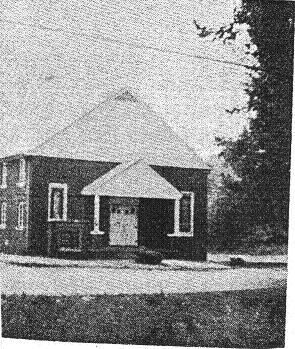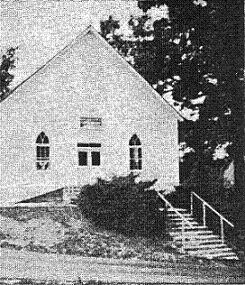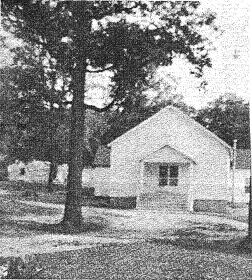
Drakesboro First Baptist Church
[p. 124]
in existence today is a minute and roll book begun in 1902 The first business recorded concerned a "well published and announced call meeting for the calling of a pastor, which resulted in the election of Bro. F. G. Jones by an overwhelming majority" (Quoted material in this history is taken from local church records )
All these early minutes list as one of the first items of business an inquiry "as to the peace and fellowship of the church." This fellowship was evidently cemented by church discipline that was indeed a reality in this period. On July 4, 1902, the church voted to withdraw fellowship from two of its members. Another similar case was "laid over until the next meeting. ".Then in February 1903, the motion was made and carried to accept this wayward member's "Acknowledgement and restore him back into full fellowship."
The discussion of a new church building was officially noted as
[p. 125]
early as 1922. Evidently, however, plans progressed slowly because in October 1926. "Bro. Curl made a short talk about building a new church". Nearly a year later the question of whether to repair the old building or to enter a building program was still being debated. In July 1928 an application was sent to the Home Mission Board f the Souther Baptist Convention for the loan of $6,000 "to be used solely for the purpose of completing payment on our church building" This building refers to the one in which we now worship, which was the original frame structure erected on the present Church of Christ site. This wooden building was moved in 1928 to the present location and was overlaid with brick.
[p. 126]
to remodel the church and to add necessary space. In March the church approved the recommendations of the building committee. These plans included the extension of the front of the building and the construction of a baptistry. The cost was estimated at $10,500. A contract for the construction was let on May 18.

Dunmor Baptist Church
[p. 127]
[p. 128]
After the foregoing was written, Brother Leon E. Chilton submitted the following data:

East Union Baptist Church
[p. 129]
due to their age and are not intelligible.
"The church at East Union was organized on the 14th day of August, 1852, and proceeded in business as follows: 1st: Chose a pastor, to wit: Elder William Bennett. 2nd: Appointed a clerk, to wit: A. M. Lewis. 3rd: The day of meeting to be on Saturday preceding the fourth Sabbath in each month. P. S. Lovin, moderator, A. M. Lewis, clerk."
[p. 130]
Wiley Tyson. Brother Elder William Bennett, moderator and Brother A. M. Lewis, clerk."
"The building was a one-room log house approximately 20 by 30 feet, a door in each end, two windows on each side. Each sill was a complete log, no splices. The logs from the windows up were complete logs with no splices. The logs averaged approximately 14 inches in width, hewed on each side. One log extended down the center of the building and was supported by sassafras posts. The ceiling of the church was level with the top of the center log, leaving the log exposed inside the church; but soon they cased this log and the posts down the center with poplar boards. The space between each log was chinked with short blocks of wood placed between the logs, and daubed with mortar made from lime. In making mortar for the last coat, much lime was used to make the mortar white. Boards were used for the roof. The rafters, not being properly supported, let the roof sag very much in the center of the building."
In the age of the first building, the people walked to church.
[p. 131]
Often the ladies walked, carrying their shoes. When they drew near the church, they stopped, put on their shoes, and went on to church. After they had worshipped and departed for home, again they removed their shoes. Soon came the days of the wagon and of horse back riding. The horses were arrayed with side saddles on which the ladies joyfully rode to church. There were stile blocks which aided them in mounting and dismounting. Many came to church by wagon. After this age came the horse and buggy days. Sundays were greatly anticipated, for young men gleefully took their girl friends to church by means of horse and buggy. We are all very well acquainted with the present automobile age.
[p. 132]
[p. 133]

Ebenezer Baptist Church
Organized January 3, 1851, by Elders J. U. Spurlin, C. Meacham, with members holding letters from Hazel Creek Church, viz.: John A. Wilkinson, Sarah Wilkinson, R. B. Landrum, Nancy Landrum, Mary Casebier, David Casebier, Nancy Cundiff, Susan Cundiff, Joseph Adcock, Mary Adcock, Elizabeth Adcock, W. A. Turner, Henry Rhoads, Elizabeth Rhoads, Ann E. Langley, Susan Unsel, Margaret Wade, J. M. Vaught, Elizabeth Dakes, Wm. Jones, Mary E. Lambert, Martha H. Bell, Hannah Bell, J. J. Cundiff. Joined the Gasper River Association the same year.
[p. 134]
[p. 135]

Forest Grove Baptist Church
[p. 136]
[p. 137]

Friendship Baptist Church
"We the United Baptist Church of Christ, formerly part of Cave Spring Church of Muhlenberg County, Kentucky, being dismissed for the purpose of forming a new church, met at Bro. Andrew I. Turner's on Saturday before the 3rd Lord's Day in January, 1840, and after Divine service was constituted by a presbytery composed of Brethren R. Jones and K. G. Hay of Little Bethel Association."
[p. 138]
"In November 1878 a twelve day meeting was held resulting in 17 conversions and 21 additions to the church. . . . Meeting was conducted by the pastor, F. M. Welborn.""In October 1882 a series of meetings were held with 12 conversions."
"In February 1885 there were 11 conversions and 14 additions to the church during a fifteen day revival."
"In 1887 a series of meetings conducted by Elder J. T. Casebier resulted in 33 additions to the church, 30 by experience and baptism."
"In November 1889 a gracious revival was held wtih Rev. W. P. Henry assisting Rev. J. T. Casebier. There was a total addition of 40 members to the church, 35 by profession of faith and baptism."
"In November 1891 during a revival of 21 days — W. H. Woodson, pastor — 25 souls were saved."
"In December 1894 a revival was held by W. H. Woodson. . . . 18 souls were happily converted."
[p. 139]
added to the services she offered her members. For many years this was limited to preaching one Sunday a month and the annual protracted meeting.
K. G. Hay, 1840-1848; John Walker, 1849; William D. Pannell, 1850-1859 and 1866-1868; T. D. Rust, 1862-1865, 1870-1873, 1875-1877; Bro. James, 1869; Bro. Craig, 1874; F. M. Welborn, 1878; J. T. Casebier, 1885-1890, 1898, 1899; W. H. Woodson, 1891,1897, 1908-1910, 1920, 1921; J. W. Gill, 1901, 1905-1907; J. R. Jenkins 1902-1904; R. C. Allen, 1911-1914; T. G. Woodson, 1915-1919; E. Grimes, 1922-1924; S. P. Shanks, 1925-1926; Drexel Hankins, 1927-1928; R. H. Forsythe, 1929-1932; Fred Fox, 1933-1947, 1950-1952, 1961 to present, 1965; J. L. Parker, 1948-1949; Melvin A. Johnson, 1953-1954; John S. Jennings, 1955-1956; Charles Woodburn, 1957-1960. It will be noted that Bro. Fred Fox has served the church for a greater number of years than any other of her pastors.
[p. 140]
[p. 141]
[p. 142]
teaching, and Bible study were held by local, county, and state workers. Records show that 15 teachers in this Sunday School held the Normal Diploma in 1934; and in the following years training was consistently continued in Sunday School and Vacation Bible School work. The Sunday ^School attained "Standard" recognition by the State Sunday School Department year after year. Two of its workers, Mr. Purvis and Mr. Winebarger, were Associational Sunday School superintendents for a number of years, and other workers from this church were on the Associational Sunday School staff as conference leaders.
The following table shows church expenditures from 1907 through 1965:
Local Total
Year All Missions Expenditures Expenditures
1907-1920 $ 296.55 $2,831.00 $3,127.55
1921-1930 1,661.00 6,507.00 8,168.00
1931-1940 217.50 4,555.00 4,772.50
1941-1950 5,391.50 24,561.00 19,952.50
1951-1960 10,025.00 79,751.00 89,776.00
1961-1965 4,960.00 31,382.00 36,342.00
Total $22,551.55 $194,587.00 $217,138.55
[p. 143]
[p. 144]
ordained as deacons. A constitution sermon was delivered for Dr. Coleman. Rules of decorum were presented. One candidate for baptism, Martin Marshel, was received; also another person by letter. After a night service the meeting was adjourned until the first Saturday in July. The building committee purchased an acre lot on North Cherry Street for $400.00, and a brick building, having a basement and a regular auditorium, was erected. The basement floor was rented out for several years for a privade school. This building was comleted in 1871.
[p. 145]
Adopted June 12, 1869
[p. 146]
Along about 1939, Clyde R. Widick, pastor of the First Baptist Church, carried on his brush-arbor revival on a lot between the railroad tracks and Wickliffe Street. In the years that followed, several tent revivals were held on West Depot Street on the Home Milling Company lot, and buses were run on Sundays to carry people from the Depot to First Baptist.
[p. 147]
[p. 148]
[p. 149]
Maddux in the October revival were held in 1964. Brother R. S. Puckett led one in May; Mrother Marshall Phillips the other in November. Brother W. K. Wood was the evangelist in April and Brother Garlan Sills in October of 1965.
[p. 150]
outlay, she contributed over $5,000 to missions during 1963 and during 1964.
[p. 151]
the hearts of the members of the old body, whether they ever worship in it or not. All the many precious souls who gave themselves to God at this sacred spot, or nearly all, have gone to their reward."